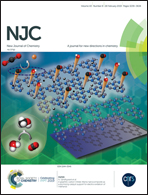A label-free and fluorescence turn-on assay for sensitive detection of hyaluronidase based on hyaluronan-induced perylene self-assembly†
Abstract
Hyaluronidase (HAase) has been reported as a diagnostic and prognostic urinary biomarker for bladder cancer. Simple and sensitive methods capable of quantitatively detecting HAase are desired for tumor diagnosis and therapy at its early stage. Herein, a label-free and fluorescence “turn-on” assay for sensitive detection of HAase was established based on the electrostatic assembly of a water-soluble cationic perylene diimide derivative (PDI) and hyaluronic acid (HA). The electrostatic assembly of HA–PDI between the positively charged PDI and the negatively charged HA resulted in an efficient aggregation-caused quenching (ACQ) of PDI. In the presence of HAase, the enzyme catalyzed hydrolysis of HA led to the failure of aggregation of PDI and thus the fluorescence of PDI was retained. HA was used to function not only as a scaffold to agglomerate PDI but also as a substrate for enzymatic reactions. The efficient ACQ and the specific enzymatic reaction induced failure of aggregation of PDI endowed the developed HA–PDI assembly with high sensitivity and specificity for the detection of HAase with a detection limit of 0.03 U mL−1. Moreover, the facile detection process and rapid response of the assay made it applicable for reliable detection of HAase in human serum and urine samples.



 Please wait while we load your content...
Please wait while we load your content...